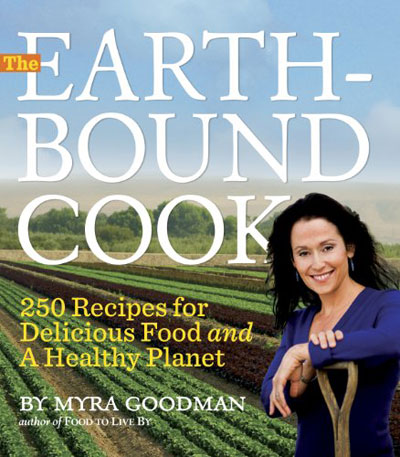
Food is all around us. It is a part of our culture and our daily lives. Food sustains us. But have you noticed that we as humans have not been so great at sustaining our food, or even the planet that supplies that food.
Perhaps because man is a survivor by instinct, and because food is necessary to our biological survival, could it be that we have taken on a conquer and control attitude about its production and collection?
The irony is that if we continue to consume our planet’s resources (including food) without allowing for its sustainability we will be doomed. The very survival instinct that drives us to conquer and destroy could be our downfall.
Yikes, those are pretty dark thoughts coming from Sippity Sup. Isn’t Sippity Sup a fun food blog? Well yes, but Sippity Sup is also a serious food blog. Serious Fun Food. Remember?
So today I bring you a few thoughts about a new cookbook called The Earthbound Cook, written by Myra Goodman, the author of Food To Live By. It’s a cookbook dedicated to delicious food and a healthy planet.
It’s a big, ambitious book with 250 recipes divided into 11 chapters: Soup, Leafy Green Salads, Meat and Poultry, Fish and Shellfish, Vegetarian Entrees, Side Dishes, Vegetable and Grain Salads, Baking Bread, Desserts, Breakfast and Brunch and Pantry Basics. Each chapter also contains important information concerning eco-minded living and primers dedicated to helping you become more conscientious about how you cook and how your choices affect the planet that provides the food you cook.
 For example, I’m sure you realize the importance of water conservation. This topic is addressed appropriately in a chapter devoted to soup. But did you know that there are environmental considerations concerning the packaging of the broth you buy for that soup, too? More food for thought.
For example, I’m sure you realize the importance of water conservation. This topic is addressed appropriately in a chapter devoted to soup. But did you know that there are environmental considerations concerning the packaging of the broth you buy for that soup, too? More food for thought.
The author’s philosophy on organic food and farming, though slightly different from my own, is passionately addressed in the chapter on leafy greens. The leafy greens chapter also contains a super useful field guide to salad greens with photos designed to clear up that age-old question “is this endive or escarole?”
There are so many things to consider when choosing foods that sustain the planet as well as fill our bellies. It’s a subject I am passionate about and I happy to say this book fed that passion. I am already familiar with some of the topics covered, but there is also so much new information that I will turn to this book as I try to become a more responsible consumer.
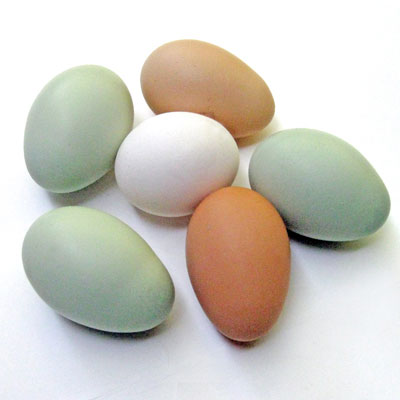 Take eggs. I mean who’s not thinking about eggs and where they come from these days? In the most eye-opening section of the book (for me) Egg Label Claims: What Are They Talking About? I learned that there is very little regulation or standardization when it comes to the claims we see printed on egg cartons. What exactly does “organic” mean? Is there a difference between “free range” and “cage free”? Now you might roll your eyes and label me a geek. But I always stare at those cartons wondering exactly which to buy and why.
Take eggs. I mean who’s not thinking about eggs and where they come from these days? In the most eye-opening section of the book (for me) Egg Label Claims: What Are They Talking About? I learned that there is very little regulation or standardization when it comes to the claims we see printed on egg cartons. What exactly does “organic” mean? Is there a difference between “free range” and “cage free”? Now you might roll your eyes and label me a geek. But I always stare at those cartons wondering exactly which to buy and why.
Because terms like “farm fresh”, “healthy” or “naturally raised” honestly mean nothing to me. It’s not a third-party, objective certification based on established criteria. After all, arsenic is a “natural”, “organic” compound. So when I look at those cartons and I read those phrases I can’t be sure they help me make the best possible choice. So I am left with all kinds of questions.
Well, this book answers my egg questions. Which doesn’t mean this book has all the answers, because the entire topic is complicated and diverse. But this book does get the conversation started and keeps it going. That is so important.
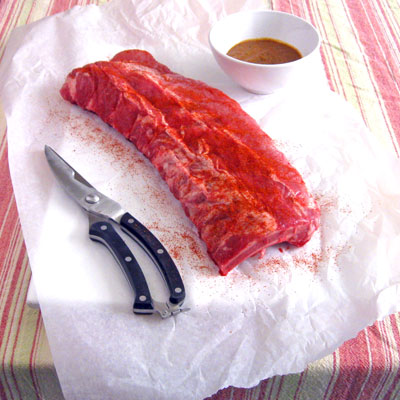 I believe this book has broad appeal as well. There are way too many stereotypes about organics, vegetarians and vegans. I was a bit concerned that this book would take a holier-than-thou approach when it came to meat. Instead, there is an informative section about making eco-friendly meat choices. As with most environmental concerns this is a very complicated subject. Meat production does require a large amount of resources, and it does contribute “disproportionably to global warming”. So we as consumers, need to use our almighty dollars to encourage change within the system. Which is a much more pragmatic, open-minded approach than merely proclaiming for-one-and-for-all that meat consumption is wrong. Because I don’t believe that it is, and this book does a great job in explaining why the current system of meat production isn’t working as well for the planet as it should.
I believe this book has broad appeal as well. There are way too many stereotypes about organics, vegetarians and vegans. I was a bit concerned that this book would take a holier-than-thou approach when it came to meat. Instead, there is an informative section about making eco-friendly meat choices. As with most environmental concerns this is a very complicated subject. Meat production does require a large amount of resources, and it does contribute “disproportionably to global warming”. So we as consumers, need to use our almighty dollars to encourage change within the system. Which is a much more pragmatic, open-minded approach than merely proclaiming for-one-and-for-all that meat consumption is wrong. Because I don’t believe that it is, and this book does a great job in explaining why the current system of meat production isn’t working as well for the planet as it should.
As useful as all the eco-minded information is, let’s face it I am a cook first. I am most interested in what this book has to offer in the way of recipes. So I decided to “conquer” some of this food on my own.
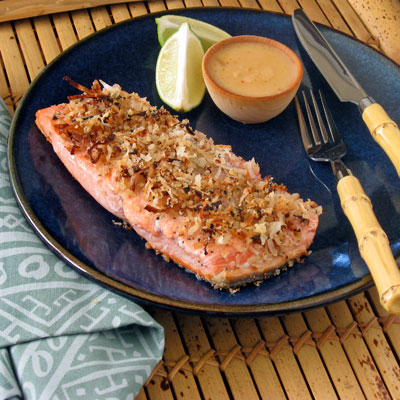 And I’ll be honest. Most of the recipes in this book won’t stretch your culinary skills in any serious way. And that’s a good thing. Because the important lessons here go way beyond braising. These recipes teach you to incorporate sustainability into your everyday life, without making any serious sacrifices for the things you love. The recipes are straightforward, and they are well-written. They will inspire you to be a better citizen of this great planet. They emphasize a lot of beautiful produce. I think this book is a real boon to those of us trying to start our children out with a healthy attitude about food and a realistic idea about where it comes from. Because each recipe uniquely addresses some aspect of sustainability and is designed to get us thinking more broadly about food.
And I’ll be honest. Most of the recipes in this book won’t stretch your culinary skills in any serious way. And that’s a good thing. Because the important lessons here go way beyond braising. These recipes teach you to incorporate sustainability into your everyday life, without making any serious sacrifices for the things you love. The recipes are straightforward, and they are well-written. They will inspire you to be a better citizen of this great planet. They emphasize a lot of beautiful produce. I think this book is a real boon to those of us trying to start our children out with a healthy attitude about food and a realistic idea about where it comes from. Because each recipe uniquely addresses some aspect of sustainability and is designed to get us thinking more broadly about food.
I chose to make Coconut-Crusted Salmon with Coconut Chili Sauce. It’s an impressive looking, Asian-inspired dish that is described by the author as the sort of meal “seen on menus at high-end restaurants”, yet is delightfully “easy to make”. I agree with her on both points.
But do me a favor, as you make this dish please refer to section in the book that talks about making sustainable seafood choices. You might just be surprised what you learn. I know I was.
I have one copy of this book available as a GIVEAWAY. All you need to do to get entered is leave a message here, tweet using the phrase #EARTHBOUNDCOOK, or “like” this on SippitySup’s Facebook page. There will be a “live” video drawing next Monday, September 27th to dertermine the winner.
This Earthbound Cook review was sponsored by Workman Publishing and is part of the Kitchen Play Pampered Pantry. To find out more about Kitchen Play, CLICK here!
Coconut-Crusted Salmon with Coconut Chili Sauce serves 6 CLICK here for a printable recipe
- 1 c unsweetened coconut milk
- 3 T fresh lime juice
- 1 T honey
- 1⁄2 T thai chili paste
- salt and pepper, as needed
- 1⁄2 c shredded, unsweetened coconut
- 1⁄4 c panko
- 6 skinless, wild salmon fillets
- 2 T peanut oil
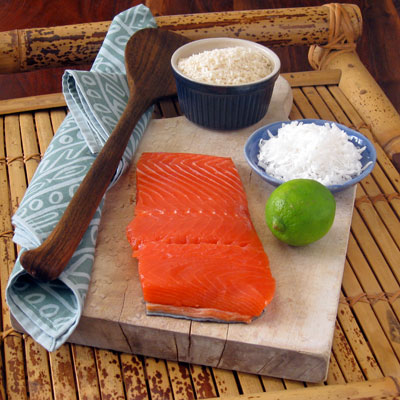 To make the sauce: Combine the coconut milk, 1 tablespoon lime juice, honey, and chili paste in a small saucepan and cook over medium-high heat until the sauce reduces and thickened slightly, about 4 minutes. Season the sauce with salt to taste. The sauce may be refrigerated, covered, for up to 5 days.
To make the sauce: Combine the coconut milk, 1 tablespoon lime juice, honey, and chili paste in a small saucepan and cook over medium-high heat until the sauce reduces and thickened slightly, about 4 minutes. Season the sauce with salt to taste. The sauce may be refrigerated, covered, for up to 5 days.
Prepare the fish: Position a rack in the middle of the oven and preheat to 375 F.
Combine the shredded coconut, panko, 1/2 teaspoon salt, and 1/4 teaspoon pepper in a small bowl. Toss well, and then spread the mixture on a plate.
Brush the top sides of the salmon with lime juice. Lightly season the fish with salt and pepper. One piece at a time, dip the top side of each fillet in the coconut-panko mixture, making sure the surface is coated. Pat the mixture onto the fish, if necessary.
Set a large, heavy-bottomed skillet, preferable cast-iron, over medium heat. When the skillet is hot, add the peanut oil. Arrange half the salmon fillets, coconut side down, in the skillet and cook for 3 minutes to sear the fish and brown the topping. carefully flip the fish over and cook another 3 minutes. Using a spatula, transfer the fish to a baking sheet. Repeat with the remaining 3 fillets.
Transfer the baking sheet to the oven and bake until the salmon is just firm to the touch and the interior is nearly opaque, but still moist, 2 to 4 minutes depending on thickness of the fish (alternatively, use an instant read thermometer; the fish will be done when the temperature reaches 130 degrees F.)
Place each fillet of salmon on a warmed plate. Drizzle with Coconut Chili Sauce and serve.
Greg Henry
Sippity Sup
Earthbound Cook
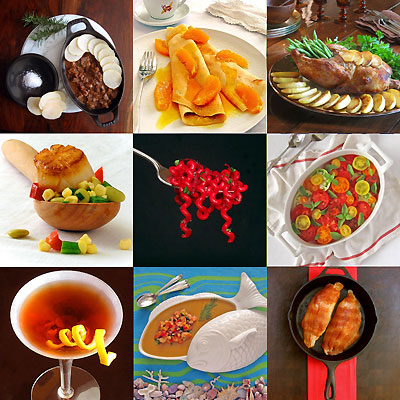

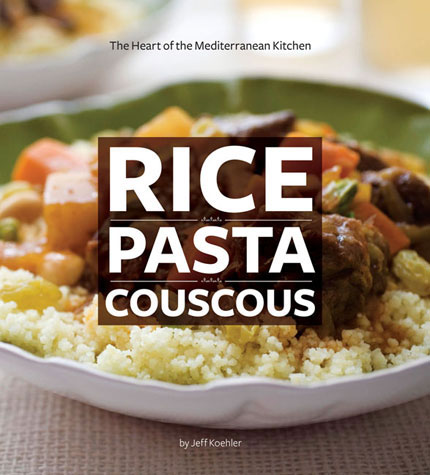
These sticks reminds me of spiced up french fries. I’ll try it with some variations (in the sauce!) Thanks for sharing.
I thought it said ‘mary jane’ dipping sauce, and I thought something herby was going array over here 🙂 and man that party must have been a good one!
I can just taste these gorgeous little sticks dipped in marinara! And what fab photos!
I love the way you have styled it, stacking it like lego blocks! lol Might even get the kids to take a taste of this neat finger food. Thanks!
before you started playing with your food. Great idea with the polenta fries as party food, I’m always looking for clever additions to my appetizer repertoir, thanks for this one! — S
I like the lincoln log house picture, very fun.
These are a great appetizer, snack, finger food, amuse bouche, horsey dorves, or what ever you want to call them. I can’t wait to see the other fun ideas you come up with for this series.
I think most of us on facebook thought zucchini. This is a surprising and tasty looking twist.
Definitely no calories in anything eaten with the fingers while standing up! And the chit chat burns the calories, too, right? I love these polenta sticks and love that you slipped in broccoli. They look delicious and fun.
Back from vacation and I now have to work my way backwards to see all the wonderful things you’ve cooked — and written — while I’ve been gone.
Greg you are so right, finger food is so innocent and yet can be so very sinful! These look amazing. LOVE the Lincoln Log photo styling. Bravo friend for a recipe very well done 🙂
Love it, and the presentation is fantastic 🙂
Greg, these look delicious and they are gluten free and vegetarian. That’s nice! Bookmarking.
Oh, and thanks for that comment. I didn’t know I was in the Top 9 till I saw you and Patty’s comments right next to each other (a dork I am-smile).
Do they still make those? So much cooler and better to eat than Legos.
Greg, I love how old school this recipe feels… classic, comfort food! Broccoli is a great twist. Plus it is gluten-free which always makes me happy!
‑E
So what were you sipping with these yummy polenta sticks 🙂 Beautiful presentation — an event that I attended recently served a stuzzichini of asiago polenta this way. Including broccoli makes me love them even more because then they’re healthy and I can eat more!
Finger foods are always inviting because it feel interactive and fun. I still haven’t tried polenta. I’m totally lagging in that department.
This makes even broccoli look so good :)))
The log cabin totally takes me back! My mom used to slice our cinnamon sugar toast into strips & make “log cabins” as a treat for breakfast.
These are so healthy and kid-friendly especially with your clever presentation in the first photo!
Finger food does remind us of parties and good times with friends.
The log cabin of polenta sticks!
Love the log cabin! Finger food rules. And I can vouch for the fact that so many kids will enjoy eating anything with their fingers. Somehow broccoli becomes yummy when you don’t have to pick it up with a fork.
Seriously? I never, never would have guessed broccoli. Polenta was in the running, but the broccoli addition is pure genius. *mwa mwa* (that’s me blowing internet kisses your way)
I love this!!! Concept, question, the WHOLE package!! Of course, it might have something to do with the fact this is one of my all time favorite categories of food — some people love to make desserts — me — I love making appetizers!!!
Polenta fries — oh the possibilities!! Your blog is dangerous… after reading each post I come up with more ideas that will keep me in the kitchen permanently (but hey, as long as I am not barefoot and pregnant, it’s all good!)
Thanks for such great inspiration!!!